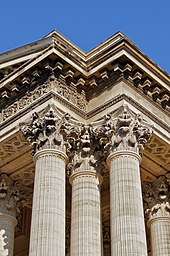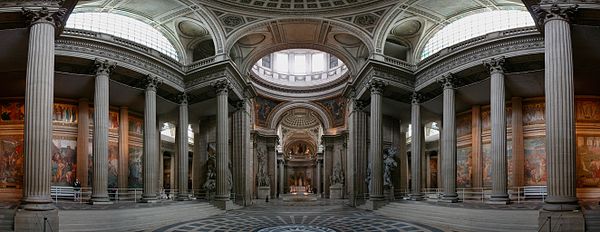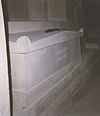Panthéon
| Le Panthéon national | |
|---|---|
 The Panthéon | |
 | |
| General information | |
| Type | Mausoleum |
| Architectural style | Neoclassicism |
| Construction started | 1758 |
| Completed | 1790 |
| Design and construction | |
| Architect(s) | Jacques-Germain Soufflot Jean-Baptiste Rondelet |
The Panthéon (Template:Lang-la,[1] from Greek Πάνθειον meaning "Every god") is a building in the Latin Quarter in Paris. It was originally built as a church dedicated to St. Genevieve and to house the reliquary châsse containing her relics but, after many changes, now functions as a secular mausoleum containing the remains of distinguished French citizens. It is an early example of neoclassicism, with a façade modeled on the Pantheon in Rome, surmounted by a dome that owes some of its character to Bramante's "Tempietto". Located in the 5th arrondissement on the Montagne Sainte-Geneviève, the Panthéon looks out over all of Paris. Designer Jacques-Germain Soufflot had the intention of combining the lightness and brightness of the gothic cathedral with classical principles, but its role as a mausoleum required the great Gothic windows to be blocked.
History



King Louis XV vowed in 1744 that if he recovered from his illness he would replace the ruined church of the Abbey of St Genevieve with an edifice worthy of the patron saint of Paris. He did recover, and entrusted Abel-François Poisson, marquis de Marigny with the fulfillment of his vow. In 1755, Marigny commissioned Jacques-Germain Soufflot to design the church, with construction beginning two years later.

The overall design was that of a Greek cross with massive portico of Corinthian columns. Its ambitious lines called for a vast building 110 meters long by 84 meters wide, and 83 meters high. No less vast was its crypt. Soufflot's masterstroke is concealed from casual view: the triple dome, each shell fitted within the others, permits a view through the oculus of the coffered inner dome of the second dome, frescoed by Antoine Gros with The Apotheosis of Saint Genevieve. The outermost dome is built of stone bound together with iron cramps and covered with lead sheathing, rather than of carpentry construction, as was the common French practice of the period. Concealed flying buttresses pass the massive weight of the triple construction outwards to the portico columns.
The foundations were laid in 1758, but due to the economic problems in France at this time, work proceeded slowly. In 1780, Soufflot died and was replaced by his student, Jean-Baptiste Rondelet. The remodeled Abbey of St. Genevieve was finally completed in 1790, coinciding with the early stages of the French Revolution. Upon the death of the popular French orator and statesman Honoré Gabriel Riqueti, comte de Mirabeau on 2 April 1791, the National Constituent Assembly, whose president had been Mirabeau, ordered that the building be changed from a church to a mausoleum for the interment of great Frenchmen, retaining Quatremère de Quincy to oversee the project. Mirabeau was the first person interred there, on 4 April 1791.[2] Jean Guillaume Moitte created a pediment sculptural group The Fatherland crowning the heroic and civic virtues that was replaced upon the Bourbon Restoration with one by David d'Angers).
Twice since then it has reverted to being a church, only to become again a meeting house dedicated to the great intellectuals of France.
In 1851, physicist Léon Foucault demonstrated the rotation of the Earth by his experiment conducted in the Panthéon, by constructing a 67 meter Foucault pendulum beneath the central dome. The original sphere from the pendulum was temporarily displayed at the Panthéon in the 1990s (starting in 1995) during renovations at the Musée des Arts et Métiers. The original pendulum was later returned to the Musée des Arts et Métiers, and a copy is now displayed at the Panthéon.[3]
From 1906 to 1922 the Panthéon was the site of Auguste Rodin's famous sculpture The Thinker.
In 2006, Ernesto Neto, a Brazilian artist, installed "Léviathan Thot", an anthropomorphic installation inspired by the biblical monster. The art installation was in the Panthéon from September 15, 2006, until October 31 for Paris' Autumn Festival.
In late 2006, a "cultural guerilla movement" calling itself Untergunther completed a year-long project by which they covertly repaired the Panthéon's antique clockworks.[4][5][6]

Burial place
The inscription above the entrance reads AUX GRANDS HOMMES LA PATRIE RECONNAISSANTE ( "To the great men, the grateful homeland"). By burying its great men in the Panthéon, the Nation acknowledges the honour it received from them. As such, internment here is severely restricted and is allowed only by a parliamentary act for "National Heroes". Similar high honours exist in Les Invalides for historical military leaders such as Napoléon, Turenne and Vauban.
Among those buried in its necropolis are Voltaire, Rousseau, Victor Hugo, Émile Zola, Jean Moulin, Marie Skłodowska-Curie, Louis Braille, Jean Jaurès and Soufflot, its architect.
The widely-repeated story that the remains of Voltaire were stolen by religious fanatics in 1814 and thrown into a garbage heap is false. Such rumours resulted in the coffin being opened in 1897, which confirmed that his remains were still present.
On 30 November 2002, in an elaborate but solemn procession, six Republican Guards carried the coffin of Alexandre Dumas (1802–1870), the author of The Three Musketeers, to the Panthéon. Draped in a blue-velvet cloth inscribed with the Musketeers' motto: "Un pour tous, tous pour un" ("One for all, all for one,") the remains had been transported from their original interment site in the Cimetière de Villers-Cotterêts in Aisne, France. In his speech, President Jacques Chirac stated that an injustice was being corrected with the proper honoring of one of France's greatest authors.
In January 2007, President Jacques Chirac unveiled a plaque in the Panthéon to more than 2600 people recognized as Righteous Among the Nations by the Yad Vashem memorial in Israel for saving the lives of Jews who would otherwise have been deported to concentration camps. The tribute in the Panthéon underlines the fact that around three quarters of the country's Jewish population survived the war, often thanks to ordinary people who provided help at the risk of their own life. This plaque says :
Sous la chape de haine et de nuit tombée sur la France dans les années d'occupation, des lumières, par milliers, refusèrent de s'éteindre. Nommés "Juste parmi les Nations" ou restés anonymes, des femmes et des hommes, de toutes origines et de toutes conditions, ont sauvé des juifs des persécutions antisémites et des camps d'extermination. Bravant les risques encourus, ils ont incarné l'honneur de la France, ses valeurs de justice, de tolérance et d'humanité.
Which can be translated as follows :
Under the cloak of hate and darkness that spread over France during the years of [Nazi] occupation, thousands of lights refused to be extinguished. Named as "Righteous among the Nations" or remaining anonymous, women and men, of all backgrounds and social classes, saved Jews from anti-Semitic persecution and the extermination camps. Braving the risks involved, they incarnated the honour of France, and its values of justice, tolerance and humanity.

Full list of people interred
| Year of burial in the Panthéon |
Name | Notes |
|---|---|---|
| 1791 | Honoré Gabriel Riqueti, comte de Mirabeau | First person honored with burial in the Panthéon, 4 April 1791. Disinterred on 25 November 1794. |
| 1791 | Voltaire | 
|
| 1792 | Nicolas-Joseph Beaurepaire | Disappeared |
| 1793 | Louis Michel le Peletier de Saint-Fargeau | Assassinated deputy, disinterred from the Panthéon. His body was removed by his family on 14 February 1795. |
| 1793 | Augustin-Marie Picot, marquis de Dampierre | Disappeared |
| 1794 | Jean-Paul Marat | Disintered from the Panthéon |
| 1794 | Jean-Jacques Rousseau | 
|
| 1806 | François Denis Tronchet | |
| 1806 | Claude-Louis Petiet | |
| 1807 | Jean-Étienne-Marie Portalis | |
| 1807 | Louis-Pierre-Pantaléon Resnier | |
| 1807 | Louis-Joseph-Charles-Amable d'Albert, duc de Luynes | Disinterred from the Panthéon |
| 1807 | Jean-Baptiste-Pierre Bévière | |
| 1808 | Francois Barthélemy, comte Béguinot | |
| 1808 | Pierre Jean George Cabanis | |
| 1808 | Gabriel-Louis, marquis de Caulaincourt | |
| 1808 | Jean-Frédéric, comte de Perregaux | |
| 1808 | Antoine-César de Choiseul, duc de Praslin | |
| 1808 | Jean-Pierre-Firmin, comte Malher | Urn with his heart |
| 1809 | Jean Baptiste Papin, comte de Saint-Christau | |
| 1809 | Joseph-Marie, comte Vien | |
| 1809 | Pierre Garnier, comte de Laboissière | |
| 1809 | Jean Pierre, comte Sers | Urn with his heart |
| 1809 | Jérôme-Louis-François-Joseph, comte de Durazzo | Urn with his heart |
| 1809 | Justin-Bonaventure, comte Morard de Galles | Urn with his heart |
| 1809 | Emmanuel Crétet, comte de Champnol | |
| 1810 | Giovanni Baptista, cardinal Caprara | |
| 1810 | Louis-Joseph-Vincent-Leblon, comte de Saint-Hilaire | |
| 1810 | Jean-Baptiste, comte Treilhard | |
| 1810 | Jean Lannes, duc de Montebello | 
|
| 1810 | Charles-Pierre-Claret, comte de Fleurieu de La Tourette | |
| 1811 | Louis Antoine de Bougainville | 
|
| 1811 | Charles, cardinal Erskine of Kellie | |
| 1811 | Alexandre-Antoine Hureau, baron de Sénarmont | Urn with his heart |
| 1811 | Ippolito Antonio, cardinal Vicenti Mareri | |
| 1811 | Nicolas-Marie, comte de Songis des Courbons | |
| 1811 | Michel Ordener, First Count Ordener[7] | |
| 1812 | Jean-Marie-François Lepaige, comte Dorsenne | |
| 1812 | Jan Willem de Winter or in French Jean Guillaume De Winter, comte de Huessen | Body only; his heart is buried in his birthplace Kampen (Netherlands) |
| 1813 | Hyacinthe-Hugues-Timoléon de Cossé, comte de Brissac | |
| 1813 | Jean-Ignace Jacqueminot, comte de Ham | |
| 1813 | Joseph Louis, comte Lagrange | |
| 1813 | Jean, comte Rousseau | |
| 1813 | François-Marie-Joseph-Justin, comte de Viry | |
| 1814 | Jean-Nicolas, comte Démeunier | |
| 1814 | Jean-Louis-Ebenezer, comte Reynier | |
| 1814 | Claude-Ambroise Régnier, duc de Massa di Carrara | |
| 1815 | Antoine-Jean-Marie, comte Thévenard | |
| 1815 | Claude-Juste-Alexandre, comte Legrand | |
| 1829 | Jacques-Germain Soufflot | |
| 1885 | Victor Hugo | 
|
| 1889 | Lazare Carnot | Buried at the time of the centennial celebration of the French Revolution. |
| 1889 | Théophile-Malo Corret de la Tour d'Auvergne | Buried at the time of the centennial celebration of the French Revolution. |
| 1889 | François Séverin Marceau-Desgraviers | Buried at the time of the centennial celebration of the French Revolution – Only his ashes are buried there. |
| 1894 | Marie François Sadi Carnot | Buried immediately after his assassination. |
| 1907 | Marcellin Berthelot | Buried with his wife Mme Sophie Berthelot, the first woman to be interred. |
| 1908 | Émile Zola | |
| 1920 | Léon Gambetta | Urn with his heart |
| 1924 | Jean Jaurès | Interred ten years after his assassination. |
| 1933 | Paul Painlevé | |
| 1948 | Paul Langevin | |
| 1948 | Jean Perrin | Buried the same day as Paul Langevin. |
| 1949 | Victor Schoelcher | His father Marc, is also in the Panthéon. Victor wanted to be buried with his father. |
| 1949 | Félix Éboué | Buried the same day as Victor Schoelcher. |
| 1952 | Louis Braille | Body moved to the Panthéon on the centenary of his death. |
| 1964 | Jean Moulin | Ashes transferred from Père Lachaise Cemetery on December 19, 1964. |
| 1987 | René Cassin | Entered the Pantheon on the centenary of his birth. |
| 1988 | Jean Monnet | Entered the Pantheon on the centenary of his birth. |
| 1989 | Abbé Baptiste-Henri Grégoire | Buried at the time of the bicentennial celebration of the French Revolution. |
| 1989 | Gaspard Monge | Buried at the time of the bicentennial celebration of the French Revolution. |
| 1989 | Marquis de Condorcet | Buried at the time of the bicentennial celebration of the French Revolution. The coffin is in fact empty, his remains having been lost. |
| 1995 | Pierre Curie |  |
| 1995 | Marie Curie |  |
| 1996 | André Malraux | Ashes transferred from Verrières-le-Buisson (Essonne) Cemetery on 23 November 1996 on the twentieth anniversary of his death. |
| 2002 | Alexandre Dumas, père | Reburied here 132 years after his death. |
| 2011 | Aimé Césaire | Commemorative plaque installed 6 April 2011; Césaire is buried in Martinique.[8] |
See also
References
- ^ Rarely Pantheum. This not noticed usage appears in Pliny's Natural History (XXXVI.38) in describing this edifice: Agrippae Pantheum decoravit Diogenes Atheniensis; in columnis templi eius Caryatides probantur inter pauca operum, sicut in fastigio posita signa, sed propter altitudinem loci minus celebrata.
- ^ Comte de Mirabeau had been elected president of the National Constituent Assembly on 29 January 1791. Upon his death, the Assembly decreed that the church of St. Genevieve should be [translation] "destined to receive the ashes of great men," and that "Honore Riqueti-Mirabeau is adjudged worthy to receive that honor." Mirabeau (Antonina Vallentin; trans. by E.W. Dickes). New York: The Viking Press, 1948. pp. 496-97, 522.
- ^ [1]
- ^ Canadian Broadcasting Corporation (2007-11-26). "Paris Clock Fixers". As It Happens. Canadian Broadcasting Corporation.
- ^ King, Emilie Boyer (2007-11-26). "Undercover restorers fix Paris landmark's clock". Guardian Unlimited. Guardian Media Group.
{{cite news}}: More than one of|author=and|last=specified (help) - ^ Sage, Adam (2007-09-29). "Underground 'terrorists' with a mission to save city's neglected heritage". The Times. Times Newspapers Ltd.
{{cite news}}: More than one of|author=and|last=specified (help) - ^ (French) Charles Mullié "Michel Ordener." Biographie des célébrités militaires des armées de terre et de mer de 1789 à 1850, Paris, 1852.
- ^ France Guide (2011). "Aimé Césaire joins Voltaire and Rousseau at the Panthéon in Paris". French Government Tourist Office. Retrieved 2011-04-09.
External links
- Panthéon at Centre des Monuments Nationaux
- Panthéon - current photographs and of the years 1900
- 38 recent photos of the Panthéon
- Panthéon at Structurae
- The Pantheon Paris (unofficial site) offers a gallery of 20 images
This article needs additional citations for verification. (November 2006) |
